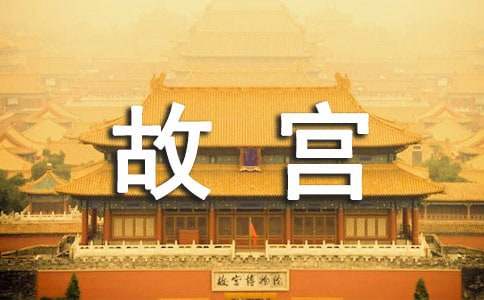故宮的英文導游詞
故宮又稱紫禁城,在北京城中心。小編收集故宮的英文導游詞,歡迎閱讀。

故宮的'英文導游詞【一】
Everybody is good! Welcome to the Palace Museum tourists sightseeing. Today, I will take you visit the Forbidden City, in the hope that visitors can enjoy me!!!!!!!
The tourists! The Palace Museum is in the Ming and qing dynasties imperial palace, the Forbidden City built on the basis of a collection of ancient buildings, collection, imperial palace culture art as one of the large-scale comprehensive museum. The Forbidden City covers an area of about more than 100 square meters, construction area of about 1 square meters. A total of 24 emperors lived in the Forbidden City, the first is the Ming dynasty yongle emperor zhu di, the last one is the qing dynasty xuantong emperor, puyi, ruled the country for 491 years. So the Palace Museum of history is very long!
Visitors, please look up, this is the meridian gate, in ancient times, what kill people to kill in front of the meridian gate! From the meridian gate, we can see the jinshui bridge. From the jinshui bridge in the past, a gate, can see the Palace Museum of taihe palace, zhonghe palace and Baohe Palace, is the place where the emperor emperor, very grand. Out of Baohe Palace, a gate of heavenly purity, came to the palace of heavenly purity, this temple and palace of earthly tranquility, legend built the Forbidden City, is in order to world peace, to take these three places? Kun ning door, is the imperial garden, the garden scenery beautiful, there are a number of strange stone, come across these stones, remember pictures to commemorate!
Before the gate is her virginity and creature door, our trip to the Forbidden City is over. Look at this magnificent palace, and some loathe to give up?
故宮的英文導游詞【二】
Lying at the center of Beijing, the Forbidden City, called Gu Gong, in Chinese, was the imperial palace during the Ming and Qing dynasties. Now known as the Palace Museum, it is to the north of Tiananmen Square. Rectangular in shape, it is the world‘s largest palace complex and covers 74 hectares. Surrounded by a six meter deep moat and a ten meter high wall are 9,999 buildings. The wall has a gate on each side. Opposite the Tiananmen Gate, to the north is the Gate of Devine Might (Shenwumen), which faces Jingshan Park. The distance between these two gates is 960 meters, while the distance between the gates in the east and west walls is 750 meters. There are unique and delicately structured towers on each of the four corners of the curtain wall. These afford views over both the palace and the city outside. The Forbidden City is divided into two parts. The southern section, or the Outer Court was where the emperor exercised his supreme power over the nation. The northern section, or the Inner Court was where he lived with his royal family. Until 1924 when the last emperor of China was driven from the Inner Court, fourteen emperors of the Ming dynasty and ten emperors of the Qing dynasty had reigned here. Having been the imperial palace for some five centuries, it houses numerous rare treasures and curiosities. Listed by UNESCO as a World Cultural Heritage Site in 1987, the Palace Museum is now one of the most popular tourist attractions world wide.
Construction of the palace complex began in 1407, the 5th year of the Yongle reign of the third emperor of the Ming dynasty. It was completed fourteen years later in 1420. It was said that a million workers including one hundred thousand artisans were driven into the long-term hard labor. Stone needed was quarried from Fangshan, a suburb of Beijing. It was said a well was dug every fifty meters along the road in order to pour water onto the road in winter to slide huge stones on ice into the city. Huge amounts of timber and other materials were freighted from faraway provinces. Ancient Chinese people displayed their very considerable skills in building the Forbidden City. Take the grand red city wall for example. It has an 8.6 meters wide base reducing to 6.66 meters wide at the top. The angular shape of the wall totally frustrates attempts to climb it. The bricks were made from white lime and glutinous rice while the cement is made from glutinous rice and egg whites. These incredible materials make the wall extraordinarily strong.
Since yellow is the symbol of the royal family, it is the dominant color in the Forbidden City. Roofs are built with yellow glazed tiles; decorations in the palace are painted yellow; even the bricks on the ground are made yellow by a special process. However, there is one exception. Wenyuange, the royal library, has a black roof. The reason is that it was believed black represented water then and could extinguish fire.
Nowadays, the Forbidden City, or the Palace Museum is open to tourists from home and abroad. Splendid painted decoration on these royal architectural wonders, the grand and deluxe halls, with their surprisingly magnificent treasures will certainly satisfy "modern civilians".
【故宮的英文導游詞】相關文章:
故宮英文導游詞精選10-29
故宮英文導游詞「完整版」10-29
故宮導游詞10-18
游故宮導游詞02-28
沈陽故宮導游詞10-18
故宮的導游詞三篇02-22
故宮導游詞 15篇03-06
故宮導游詞十五篇02-26
小學北京故宮導游詞02-25
寫北京故宮導游詞02-25